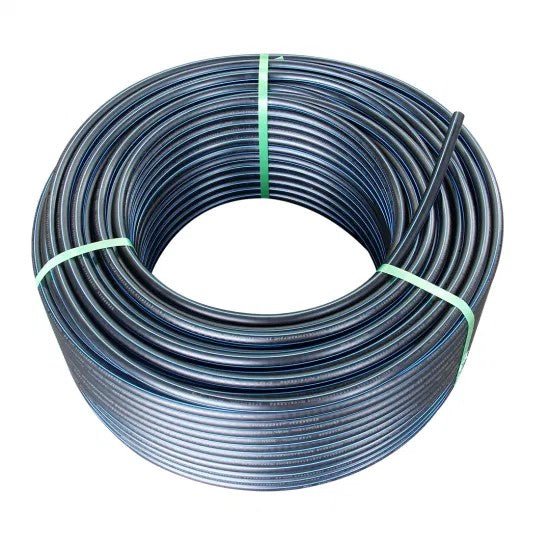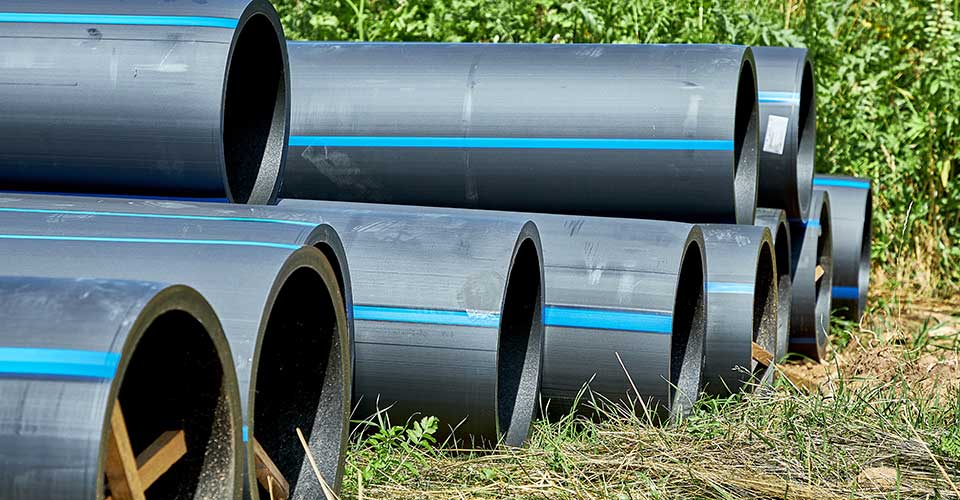How Midland TX HDPE Pipe Fittings in Stock Save Time
Discover the Manufacturing Process Behind High-Quality HDPE Pipe and Its Applications
The manufacturing process of top notch HDPE pipes is elaborate and methodical. It starts with the selection of resources that boost efficiency. Following this, ethylene undergoes polymerization to form resin, which is then formed with extrusion. Quality control is critical, guaranteeing that the end product meets stringent criteria. The trip of HDPE pipes does not finish with manufacturing. Their applications throughout numerous sectors expose a more comprehensive significance worth checking out.
Recognizing HDPE: Features and Advantages

High-density polyethylene (HDPE) is a flexible polycarbonate known for its resilience and resistance to numerous environmental aspects. This material displays exceptional tensile strength, making it appropriate for requiring applications. Its low-density structure adds to a lightweight item, helping with ease of managing and installment. HDPE likewise showcases amazing resistance to chemicals, which minimizes deterioration when revealed to severe substances.
The material's reduced wetness absorption even more enhances its long life, making it ideal for usage in pipelines and storage tanks. Furthermore, HDPE is immune to ultraviolet (UV) radiation, making certain that products keep their stability even when revealed to sunshine. Its flexibility permits for the development of elaborate shapes without jeopardizing stamina. The eco-friendly nature of HDPE, often stemmed from recycled materials, includes in its appeal, advertising sustainable techniques in production. On the whole, these properties and advantages make HDPE a favored selection for various commercial and consumer applications.
Raw Product Selection for HDPE Manufacturing
The selection of raw products for HDPE production is vital to verify the end product satisfies the wanted requirements and top quality requirements. High-density polyethylene (HDPE) is mostly generated from polymerized ethylene, acquired from fossil gas such as gas or petroleum. The top quality of these feedstocks greatly influences the mechanical and thermal residential properties of the final HDPE.
Ingredients also play a considerable role in improving HDPE's performance, consisting of antioxidants, UV stabilizers, and colorants, which improve durability and resistance to ecological variables. The option process should consider not just the chemical composition of the raw products yet additionally their processing features to ensure effective manufacturing.
In addition, the sourcing of resources should prioritize sustainability and compliance with ecological laws, as liable practices are necessary in today's market. Ultimately, cautious raw material choice lays the structure for generating high-grade HDPE pipelines ideal for varied applications.
The Extrusion Process: Forming HDPE Pipe
The extrusion process plays a crucial duty in shaping HDPE pipes, starting with precise material preparation techniques that guarantee optimal flow and consistency. Equally vital is the design of the die, which straight influences the final measurements and surface area quality of the pipe. Together, these variables contribute significantly to the effectiveness and top quality of HDPE pipeline manufacturing.
Product Prep Work Techniques
Reliable production of HDPE pipelines begins with meticulous material preparation methods, specifically the extrusion procedure. During this phase, high-density polyethylene resin is first dried to eliminate dampness, making sure perfect flow qualities. The resin is then fed right into the extruder, where it undergoes heating and melting, changing into a viscous state. This home heating process is meticulously regulated to preserve the material's stability and efficiency. The molten HDPE is compelled via a die, shaping it right into a continual pipeline kind. Proper temperature administration throughout extrusion is important, as it directly impacts the product's properties and the end product high quality. When formed, the HDPE pipeline is cooled and reduced to defined sizes, prepared for succeeding handling and applications.
Die Layout Relevance
Precision in die style plays a vital role in the extrusion procedure of HDPE pipelines. The die acts as the last shaping device, directly influencing the pipe's measurements, wall surface density, and surface area finish. A well-designed die assurances uniform material circulation, minimizing problems such as irregularities and weak points. The geometry of the die have to be maximized to fit the kitchen tap hose connector certain properties of HDPE, including its viscosity and thermal actions throughout extrusion. Additionally, the cooling rate of the material as it goes through the die can considerably influence the pipe's structural integrity. As a result, buying sophisticated die innovation is crucial for makers aiming to generate high-grade HDPE pipelines that fulfill market requirements and client assumptions.
Top Quality Control Actions in HDPE Production
Although various aspects influence the top quality of HDPE pipe production, effective quality assurance procedures are important to ensure consistency and dependability in the last item. Key quality assurance methods include strenuous product inspection, confirming that the raw polyethylene fulfills well-known requirements for purity and density. During the extrusion process, specifications such as temperature, stress, and cooling time are very closely checked to preserve dimensional precision and structural integrity
On top of that, post-production screening is crucial; makers commonly perform hydrostatic tests to evaluate the pipe's stamina and resistance to pressure. Visual assessments for surface area flaws better enhance high quality assurance. Qualification from appropriate standards companies, like ASTM or ISO, provides an additional layer of reliability. By carrying out these complete quality assurance steps, manufacturers can minimize problems, improve performance, and make certain that the HDPE pipelines fulfill the details needs of different applications, ultimately bring about client fulfillment and rely on the item.
Applications of HDPE Pipe Throughout Industries
HDPE pipelines are made use of across various fields as a result of their sturdiness and flexibility. In water distribution systems, they ensure reliable delivery, while in wastewater monitoring, they supply dependable solutions for waste transportation. Additionally, agricultural irrigation networks profit from HDPE's resistance to corrosion and versatility, making it an optimal selection for contemporary farming practices.

Water Distribution Solutions
A significant variety of industries count on high-density polyethylene (HDPE) pipes for reliable water circulation systems. Known for their sturdiness and resistance to rust, HDPE pipelines are extensively used in metropolitan supply of water networks, farming watering, and commercial applications. Their light-weight nature facilitates very easy handling and setup, lowering labor prices and time. In addition, HDPE pipes can accommodate different pressure degrees, making them ideal for both low and high-pressure systems. hdpe pipe suppliers Midland TX. The flexibility of the product permits smooth assimilation into existing facilities, decreasing the demand for considerable excavation. HDPE's resistance to chemical seeping guarantees that the water delivered remains secure and tidy, making it an ideal option for maintaining the high quality of drinkable water throughout various markets.
Wastewater Administration Solutions
Reliable water circulation systems also lead the way for innovative wastewater management remedies, where high-density polyethylene (HDPE) pipelines play a substantial role. Prominent for their durability and resistance to corrosion, HDPE pipes are suitable for transporting wastewater in various settings. Their versatility enables easy installment in intricate environments, lessening the demand browse around this web-site for comprehensive excavation. Furthermore, HDPE's smooth indoor surface lowers rubbing, boosting flow prices and effectiveness. These pipes are additionally immune to chemical leaching, guaranteeing that contaminants do not jeopardize the surrounding environment. Industries, districts, and therapy centers increasingly depend on HDPE pipelines for their integrity and durability, making them a favored selection for contemporary wastewater monitoring systems. This flexibility underscores the vital relevance of HDPE pipelines across many applications.
Agricultural Watering Networks
Agricultural watering networks benefit considerably from the usage of high-density polyethylene (HDPE) pipelines, which provide effective and trusted water shipment to plants. HDPE pipes are light-weight, making them very easy to deliver and install, while their versatility allows for different arrangements in diverse surfaces. These pipelines show exceptional resistance to corrosion, chemicals, and UV radiation, making sure sturdiness in harsh agricultural atmospheres. In addition, their smooth indoor surface decreases friction loss, enhancing water circulation and decreasing power expenses related to pumping. The long life of HDPE pipelines, commonly surpassing half a century, adds to decrease maintenance and replacement expenses. Farmers increasingly rely on HDPE pipelines to improve watering effectiveness and advertise lasting farming practices, ultimately leading to enhanced crop returns and source preservation.

Future Trends in HDPE Pipe Innovation
As the demand for lasting and efficient infrastructure grows, improvements in HDPE pipeline innovation are poised to change numerous industries. Arising patterns consist of the assimilation of clever innovations, such as sensors and IoT capacities, which facilitate real-time tracking of pipeline conditions, minimizing upkeep costs and protecting against leakages. Furthermore, the development of innovative production techniques, such as 3D printing, is enabling the production of complex, customized pipeline layouts that accommodate certain task requirements.
Additionally, the emphasis on recycling and round economic situation practices is driving the innovation of HDPE pipes made from recycled products, improving sustainability. Enhanced jointing techniques, such as electro-fusion and mechanical fittings, are additionally enhancing setup efficiency and reliability. Lastly, the growing focus on environmental policies is pressing suppliers to embrace greener manufacturing processes, ensuring that HDPE pipelines not just fulfill industry standards but also cultivate an even more sustainable future for facilities growth.
Frequently Asked Inquiries
How Does HDPE Compare to Other Plastic Materials?
HDPE surpasses lots of other plastic products relating to durability, chemical resistance, and versatility. Its Learn More low thickness and high tensile stamina make it excellent for various applications, usually going beyond choices in both performance and longevity.
What Are the Environmental Influences of HDPE Production?
The environmental effects of HDPE production consist of greenhouse gas exhausts, power intake, and potential contamination from producing procedures. Additionally, incorrect disposal can result in dirt and water contamination, elevating issues regarding long-lasting ecological results.
Can HDPE Pipes Be Reused?
Yes, HDPE pipelines can be reused. Many facilities accept made use of HDPE for handling, transforming it into brand-new items. This recycling contributes to sustainability initiatives, lowering plastic waste while preserving sources and energy in the manufacturing cycle.
What Is the Life-span of HDPE Pipeline?

Just How Do Temperature Variants Impact HDPE Pipeline Performance?
Temperature level variants considerably affect HDPE pipeline performance, affecting versatility and stamina. Heats can lead to softening, while low temperature levels may trigger brittleness, eventually influencing the pipe's longevity and suitability for various applications in diverse environments.